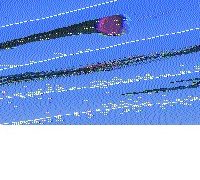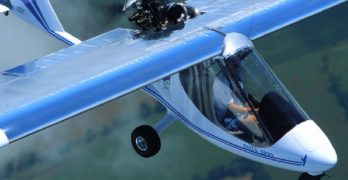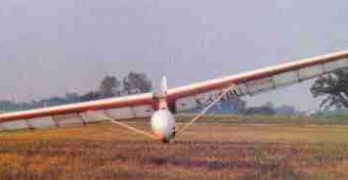In a calculated move planned for over a year, powered parachute leader Buckeye Industries introduced their new trike line at AirVenture ’98. This marks two points of interest to EXPERIMENTER readers.
The first point is a significant entry to the trike market, a segment of ultralight aircraft that has finally shown real growth potential after many years of effort by trike makers. Though European companies threw open the door with persistent marketing efforts mimicked by a few Yankee builders, Buckeye’s entry to the field could increase the number of trikes sold by a good margin.
Secondly, as a widely acknowledged sales leader among powered parachute builders, Buckeye is making something of a statement to that community of aviation enthusiasts. Powered parachutes deserve a follow-on aircraft and Buckeye has decided (logically, to my view) to make that successor a trike.
And, Why Not?
If you owned Buckeye and already made a slick, wheeled carriage for your powered parachutes, wouldn’t you also leverage that design to work for a trike?
Search Results for : series
Not finding exactly what you expected? Try our advanced search option.
Select a manufacturer to go straight to all our content about that manufacturer.
Select an aircraft model to go straight to all our content about that model.
Built for two
After ten years of producing exclusively single seaters, Tennessee-based TEAM Aircraft broke with tradition and rolled out their very first two seater, the Tandem Air-Bike, at Sun ‘n Fun ’96, following the company’s successful Air-Bike design debuted two years earlier.
Wayne Ison’s TEAM got a lot of attention from the Air-Bike – it being regarded as an aircraft you get on, not in. That same sporty, fun-to-fly concept has now stretched into a two-seat model.
Some buyers will use the Airbike Tandem for instruction under the training exemption to Part 103. Others will N-number the machine and use it for the occasional joy ride with a passenger. It should work well either way. In fact, the close-quarters tandem seating means that when the aircraft is flown solo, it should perform well and yet feel more like the agile single seater than some other designs. This theory has worked well for Kolb and their Firefly II, for example.
Facing the buying decision
What Kind of Pilot Are You?
Let’s just say you actually know yourself. While this sounds like a comment that deserves a “duh!” response, don’t be too quick to judge. If every pilot or buyer of an aircraft knew what he/she needed or wanted, my job would be easier. But it isn’t so. Most pilots know something about what they want, but many don’t have enough information to make the best decision.
Some readers are “experts.” A good many ultralight or light plane enthusiasts have been around long enough and owned enough of a variety of ultralights to know what they like. These veteran sport aviators represent a lot of combined experience. If you’re new to ultralight flying, I strongly encourage you to seek out local experts. They can be your very best source of information because they know you. (However, as I reminded you last time, remember that anybody selling any aircraft – whether their own or one they represent – has a bias that you must not overlook.
Gull flying in a new millenium
It is Mark’s design philosophy to make the most efficient aircraft he can, one that will use the least fuel. He defines himself as “a minimalist,” and this sentiment is carried throughout this beautifully optimized aircraft.
To me, Mark appears to have grown increasingly comfortable in his role within ultralight aviation. Relaxed and confident, he knows he has created a superior flying machine.
He also smiles a lot more these days in my opinion, thanks to a wonderful woman named Leslie who accompanied him to AirVenture 2000 in Oshkosh, Wisconsin. Married a year and a half ago, the two complement each other and make a good team.
No more tight squeezes
Perhaps it was this new personal relationship that motivated Mark to pay more attention to creature comforts. Notably, the Gull 2000 is wider than the previous single-seat or tandem two-seat Thunder Gull aircraft. Considering Mark is a lean and healthy vegetarian, his concern for broader pilots is no doubt appreciated.
Product Lines from December 2001
ST
ST. PAUL,
MINN. — Since last month’s column, I’ve been to the USHGA board
of directors meeting
in Salt Lake City, Utah. As usual, the large group of directors spent many
hours — all unpaid, volunteer work and they pay most of their expenses to do so! If you want
more details, ask your regional director or read articles elsewhere in this
magazine. ••• However, my focus at these meetings is as chair
of the Publications Committee. Often, this committee’s work is obscure
but this time, the committee recommended and the full board blessed an idea
that will affect everyone in Yooshga, including both hang gliding and paragliding pilots.
The committee recommended and the board approved a plan to combine our two
magazines into one.
• Now, before I go off and make someone angry, let me stress that you
will see articles in both magazines surrounding this change AND members will be given a chance to
provide their thoughts.
Polaris Slip
Here’s Polar Star’s entry in the minitrike sweepstakes.
You probably know Polaris even if you aren’t aware of the company name. Odds are good you’ve seen a picture of the Polaris inflatable flying boat. This is a trike with a small boat built around a steel trike frame. It looks unusual and remains unique.
Polaris claims to have shipped over 600 of these flying inflatable boats, once known as the Air Dinghy. The company reports these are flying around the world, owned by tourist resorts, Navy and police departments, Greenpeace ships, yacht owners, research marine institutions, and private pilots.
The company originated in Italy but opened an American office after founder, Doi Malingri, retired in Florida. Along with several Americans including Dave Melillo and Vince Kaufman, Malingri has established a U.S distribution center called Polar Star Group, a division of Polaris Motor.
Established in 1982, Polaris is experienced in aircraft manufacturing.
Marske Sailplanes
The Marske Monarch continues to offer economical soaring.
Ultralight sailplanes. Are they a new category of aviation, a segment of ultralight aircraft or just little sailplanes? Though ultralights seem to be some of the newer aircraft in general aviation, their true lineage is based on soaring machines.
For example, the first and still most successful ultralights, the Quicksilver series, came from a hang glider design to which a small engine was added back in the 1970s. Trikes, which have continued to grow in worldwide popularity, are based on delta-wing hang gliders to which power and landing gear were added. Therefore, though the term may be relatively new (going back a decade or so), the aircraft has a longer heritage. One shining example of this is Jim Marske’s Monarch.
New Model, Old Design
Marske has been building the Monarch for 20 years and has added his higher performance model, the Pioneer, to his list of designs spanning 40 years.
- « Previous Page
- 1
- …
- 63
- 64
- 65





